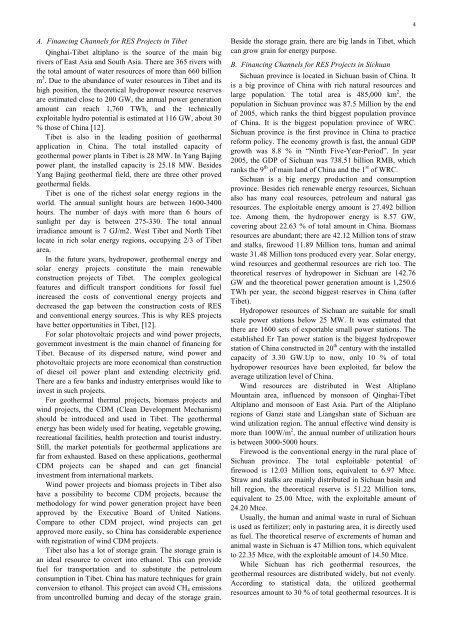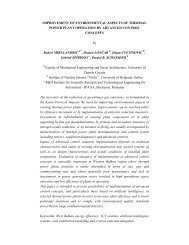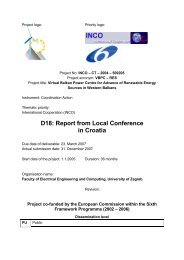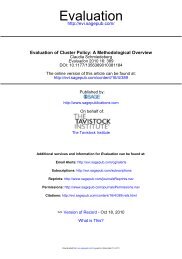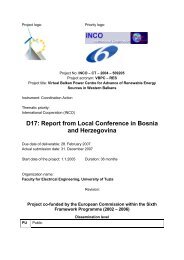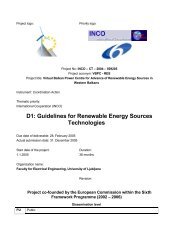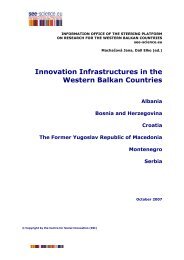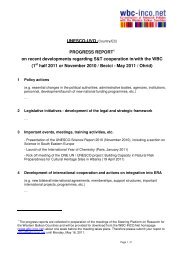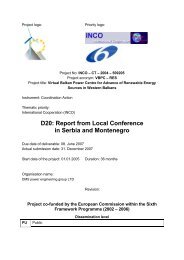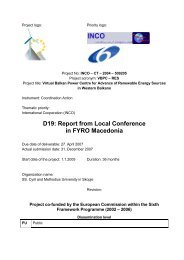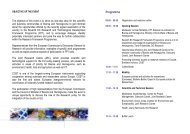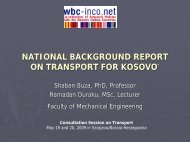Prva stran - WBC-INCO Net
Prva stran - WBC-INCO Net
Prva stran - WBC-INCO Net
You also want an ePaper? Increase the reach of your titles
YUMPU automatically turns print PDFs into web optimized ePapers that Google loves.
A. Financing Channels for RES Projects in Tibet<br />
Qinghai-Tibet altiplano is the source of the main big<br />
rivers of East Asia and South Asia. There are 365 rivers with<br />
the total amount of water resources of more than 660 billion<br />
m 3 . Due to the abundance of water resources in Tibet and its<br />
high position, the theoretical hydropower resource reserves<br />
are estimated close to 200 GW, the annual power generation<br />
amount can reach 1,760 TWh, and the technically<br />
exploitable hydro potential is estimated at 116 GW, about 30<br />
% those of China [12].<br />
Tibet is also in the leading position of geothermal<br />
application in China. The total installed capacity of<br />
geothermal power plants in Tibet is 28 MW. In Yang Bajing<br />
power plant, the installed capacity is 25.18 MW. Besides<br />
Yang Bajing geothermal field, there are three other proved<br />
geothermal fields.<br />
Tibet is one of the richest solar energy regions in the<br />
world. The annual sunlight hours are between 1600-3400<br />
hours. The number of days with more than 6 hours of<br />
sunlight per day is between 275-330. The total annual<br />
irradiance amount is 7 GJ/m2. West Tibet and North Tibet<br />
locate in rich solar energy regions, occupying 2/3 of Tibet<br />
area.<br />
In the future years, hydropower, geothermal energy and<br />
solar energy projects constitute the main renewable<br />
construction projects of Tibet. The complex geological<br />
features and difficult transport conditions for fossil fuel<br />
increased the costs of conventional energy projects and<br />
decreased the gap between the construction costs of RES<br />
and conventional energy sources. This is why RES projects<br />
have better opportunities in Tibet, [12].<br />
For solar photovoltaic projects and wind power projects,<br />
government investment is the main channel of financing for<br />
Tibet. Because of its dispersed nature, wind power and<br />
photovoltaic projects are more economical than construction<br />
of diesel oil power plant and extending electricity grid.<br />
There are a few banks and industry enterprises would like to<br />
invest in such projects.<br />
For geothermal thermal projects, biomass projects and<br />
wind projects, the CDM (Clean Development Mechanism)<br />
should be introduced and used in Tibet. The geothermal<br />
energy has been widely used for heating, vegetable growing,<br />
recreational facilities, health protection and tourist industry.<br />
Still, the market potentials for geothermal applications are<br />
far from exhausted. Based on these applications, geothermal<br />
CDM projects can be shaped and can get financial<br />
investment from international markets.<br />
Wind power projects and biomass projects in Tibet also<br />
have a possibility to become CDM projects, because the<br />
methodology for wind power generation project have been<br />
approved by the Executive Board of United Nations.<br />
Compare to other CDM project, wind projects can get<br />
approved more easily, so China has considerable experience<br />
with registration of wind CDM projects.<br />
Tibet also has a lot of storage grain. The storage grain is<br />
an ideal resource to covert into ethanol. This can provide<br />
fuel for transportation and to substitute the petroleum<br />
consumption in Tibet. China has mature techniques for grain<br />
conversion to ethanol. This project can avoid CH4 emissions<br />
from uncontrolled burning and decay of the storage grain.<br />
Beside the storage grain, there are big lands in Tibet, which<br />
can grow grain for energy purpose.<br />
B. Financing Channels for RES Projects in Sichuan<br />
Sichuan province is located in Sichuan basin of China. It<br />
is a big province of China with rich natural resources and<br />
large population. The total area is 485,000 km 2 , the<br />
population in Sichuan province was 87.5 Million by the end<br />
of 2005, which ranks the third biggest population province<br />
of China. It is the biggest population province of WRC.<br />
Sichuan province is the first province in China to practice<br />
reform policy. The economy growth is fast, the annual GDP<br />
growth was 8.8 % in “Ninth Five-Year-Period”. In year<br />
2005, the GDP of Sichuan was 738.51 billion RMB, which<br />
ranks the 9 th of main land of China and the 1 st of WRC.<br />
Sichuan is a big energy production and consumption<br />
province. Besides rich renewable energy resources, Sichuan<br />
also has many coal resources, petroleum and natural gas<br />
resources. The exploitable energy amount is 27.492 billion<br />
tce. Among them, the hydropower energy is 8.57 GW,<br />
covering about 22.63 % of total amount in China. Biomass<br />
resources are abundant; there are 42.12 Million tons of straw<br />
and stalks, firewood 11.89 Million tons, human and animal<br />
waste 31.48 Million tons produced every year. Solar energy,<br />
wind resources and geothermal resources are rich too. The<br />
theoretical reserves of hydropower in Sichuan are 142.76<br />
GW and the theoretical power generation amount is 1,250.6<br />
TWh per year, the second biggest reserves in China (after<br />
Tibet).<br />
Hydropower resources of Sichuan are suitable for small<br />
scale power stations below 25 MW. It was estimated that<br />
there are 1600 sets of exportable small power stations. The<br />
established Er Tan power station is the biggest hydropower<br />
station of China constructed in 20 th century with the installed<br />
capacity of 3.30 GW.Up to now, only 10 % of total<br />
hydropower resources have been exploited, far below the<br />
average utilization level of China.<br />
Wind resources are distributed in West Altiplano<br />
Mountain area, influenced by monsoon of Qinghai-Tibet<br />
Altiplano and monsoon of East Asia. Part of the Altiplano<br />
regions of Ganzi state and Liangshan state of Sichuan are<br />
wind utilization region. The annual effective wind density is<br />
more than 100W/m 2 , the annual number of utilization hours<br />
is between 3000-5000 hours.<br />
Firewood is the conventional energy in the rural place of<br />
Sichuan province. The total exploitable potential of<br />
firewood is 12.03 Million tons, equivalent to 6.97 Mtce.<br />
Straw and stalks are mainly distributed in Sichuan basin and<br />
hill region, the theoretical reserve is 51.22 Million tons,<br />
equivalent to 25.00 Mtce, with the exploitable amount of<br />
24.20 Mtce.<br />
Usually, the human and animal waste in rural of Sichuan<br />
is used as fertilizer; only in pasturing area, it is directly used<br />
as fuel. The theoretical reserve of excrements of human and<br />
animal waste in Sichuan is 47 Million tons, which equivalent<br />
to 22.35 Mtce, with the exploitable amount of 14.50 Mtce.<br />
While Sichuan has rich geothermal resources, the<br />
geothermal resources are distributed widely, but not evenly.<br />
According to statistical data, the utilized geothermal<br />
resources amount to 30 % of total geothermal resources. It is<br />
4


